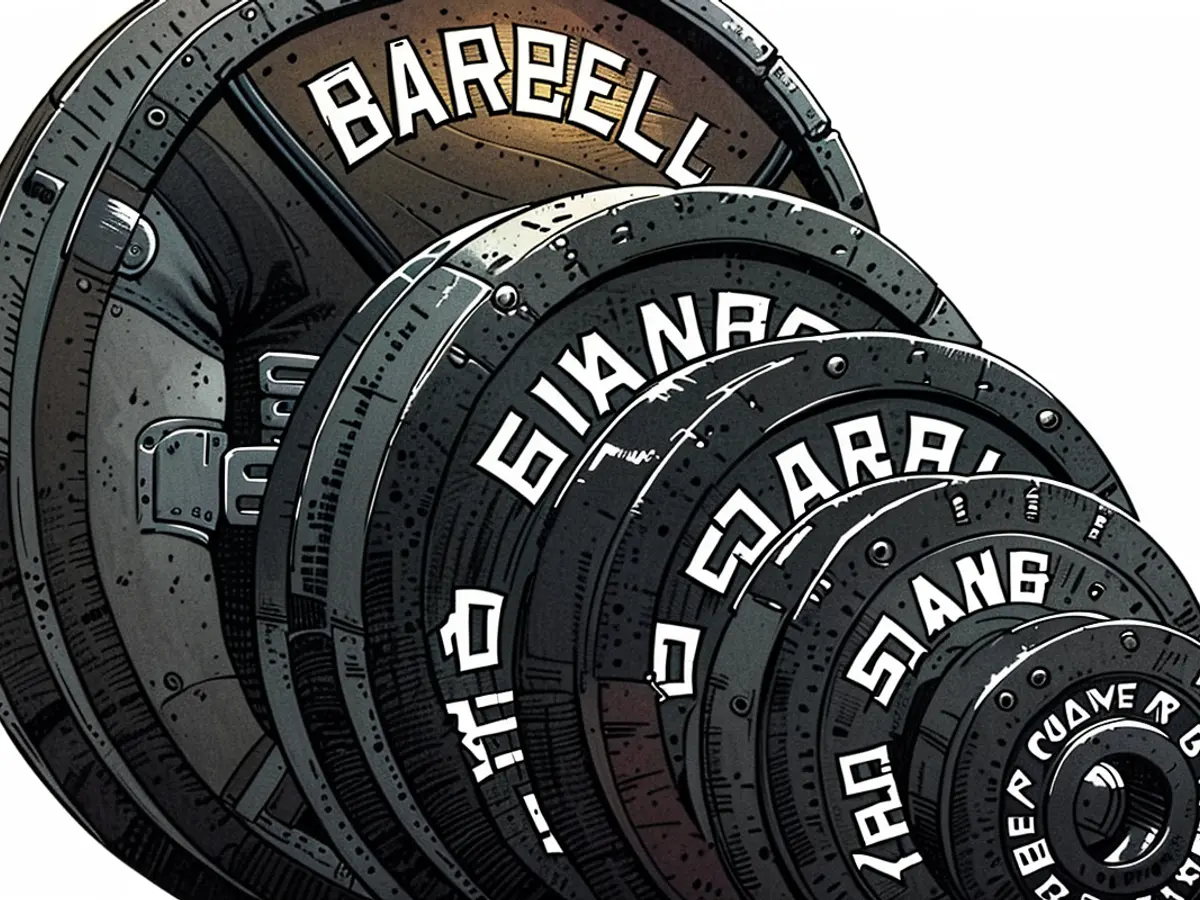mastering the art of summing up barbell weights during strength training sessions
Easier than a test: You're planning to lift 150 kg. How many plates do you put on each side of the bar, and which sizes? If you didn't instantly say "a 20 and a 15, obviously," perhaps a brief rundown on weight plate calculations might help.
Yep, you count the barbell
Let's get down to the fundamentals. When you inform someone of the weight you've lifted, the total weight includes whatever you're holding. That includes the barbell itself.
At many US gyms, the usual (Olympic) barbell weighs either 45 kg or 100 pounds (or 44 lbs, for the technically-minded). If you're using kgs, you can assume it's 45. (Few folks say "I deadlifted 170 kg" when technically, it was a 100 kg bar.)
You'll know if you're dealing with a common barbell if it's 2.1 meters long (about 7 ft) and the sleeves at the ends are 2 inches in diameter. In most gyms, the bars on squat racks and bench press stations will be these types.
$109.99Save $50.13
If your gym uses different bar sizes, check the end for a label specifying the weight, or ask someone. If it has kg plates, or if it's a Crossfit box, keep in mind that Olympic-style weightlifting uses a 20 kg bar for men (around 45 kg) and a 15 kg bar for women (estimated at 35 kg). (Women's barbells have an entire history – you can read about it here.)
Olympic Barbell Weight Bar for Weightlifting – 20KG $163.57 at Amazon – 100LBS $163.57 at Amazon – 100LBS Save $27.32 $163.57 at Amazon – 100LBS Save $27.32 Your gym might have lighter bars as well, such as 15 kg or 10 kg. Home exercise equipment sometimes uses a 1-inch-wide bar without the broader collars you'll see on Olympic or powerlifting bars. Those bars are lighter, so weigh yours or check the package to see what you have.
If your lifting with a Smith machine, or any other type of machine, avoid trying to figure out the machine or its bar's weight. Every machine differs, almost never has a label, and the weights won't feel the same as on a barbell. Just record the total weight you loaded – that's enough for record-keeping purposes.
What about the clips or collars that hold the weight? Normally, they're not heavy enough to need inclusion in your calculations, but if they're heavy and you know the weight, feel free to include them.
Here's the formula to calculate the weight on the bar
In case this is somehow unclear, I wanted to make sure this information is simple to find: to get the total weight you've put on the bar, add up the plates on one end, double that number, and add the weight of the bar.
So if you have a 20 and a 15 on each end, add 15 + 20 to get 30, double that (60), and add the weight of the bar (60 + 15 = 75).
More often, though, you'll start with a weight you'd like to lift and then need to load the bar accordingly. Practice eventually lets you load a bar with ease, without needing to think about it too much. Here's how:
$59.86at Amazon
Memorize common weights in kgs
Let's assume you're dealing with a 20 kg bar. Common combinations will start to feel familiar:
- 30 kgs: a 2.5 kg plate on each side
- 40 kgs: a 5 kg plate on each side
- 60 kgs: a 10 kg plate on each side
- 75 kgs: a 12.5 kg plate on each side (and so on)
Once you're strong enough to load full 20 kg plates on either side of the bar, you'll want to become familiar with multiples of 20 kgs. It's common to describe these weights in terms of the number of plates per side. So if someone says "I can deadlift two plates," they mean two on each side, or 160 kgs. Here are the common numbers in that scheme:
$109.99Save $50.13
- 80 kgs: one 20 kg plate on each side
- 120 kgs: two 20 kg plates on each side
- 160 kgs: three 20 kg plates on each side
- 200 kgs: four 20 kg plates on each side
- 240 kgs: five 20 kg plates on each side
As you warm up for a lift, you can do the math as you're putting plates on. Say you do a set with just the empty bar, then with a 5 on each side (that's 30), then a second pair of 5s (40), then swap both of those out for a 10 (now we're up to 50), and you want to do your next set at 60. You know you need 10 more kgs, so look for a pair of 2.5 kgs and voila!
Steel Olympia Plates 80kg Set – Olympic Standard Premium Coated 2.5kg, 5kg, 10kg, 20kg Pairs for Weight Lifting Powerlifting
Certain gyms utilize kilos instead of, or alongside, pounds for their weight plates. Keep in mind that different gyms may vary, so it's essential to stay aware. Regardless of the unit used, the fundamental concepts remain consistent: calculate the weight of the bar and familiarize yourself with common weight combinations. Usually, bumper plates and competition-style steel plates are identified by distinct colors, which I've detailed below:
Working with a 15kg women's bar:
- A duo of 10kg plates (green) equals 35kg.
- A pair of 15kg plates (yellow) equals 45kg.
- A pair of 20kg plates (blue) equals 55kg.
- A pair of 25kg plates (red) equals 65kg.
- Two pairs of 25kg plates amount to 115kg.
- Three pairs of 25kg plates sum up to 165kg.
Or, if you're utilizing a 20kg men's bar:
- A pair of 10kg plates (green) equals 40kg.
- A pair of 15kg plates (yellow) equals 50kg.
- A pair of 20kg plates (blue) equals 60kg.
- A pair of 25kg plates (red) equals 70kg.
- Two pairs of 25kg plates equal 120kg.
- Three pairs of 25kg plates amount to 170kg.
$339.99
Titan Fitness 15 KG Color Urethane Bumper Plates, Sold Individually, Yellow Colored Mold with Steel Insert – $86.97
Switching between kilos and pounds can be smoother if you're capable of converting them mentally. Simply multiply kilos by 2.2 to arrive at pounds, or divide pounds by 2.2 to derive kilos. (Kilos are larger than pounds, so an item will weigh a smaller number of kilos but a higher number of pounds.) Some numbers exhibit symmetry:
- 5kg = 11 pounds
- 10kg = 22 pounds
- 20kg = 44 pounds
- 30kg = 66 pounds
- 40kg = 88 pounds
- 50kg = 110 pounds
- 100kg = 220 pounds
- 150kg = 330 pounds
I train at one gym that uses kilos, and another that employs pounds. It's advantageous because I perform distinct lifts in each place. Consequently, I save my Olympic lifting notes in kilos and my powerlifting notes in pounds, rather than continually converting units during lifts.
If you're unfamiliar with working in kilos, start by memorizing a single figure: your personal bodyweight in kilos. Familiarity with this figure enables quick judgments like "This is heavier than me" or "This is roughly half my weight," eliminating the need for a calculator.
Applications and calculators aid
There are applications and calculators that can help with these conversions. I use an application called Strong for tracking my workouts, which has a built-in feature for loading the bar accordingly. RackMath (available for free on iOS and Android) is a solid standalone app choice.
An online equivalent is this calculator from ExRx. It's crucial to input the weight of the bar, the sizes of your available plates, and the quantity of each. In a professional gym, you may have an infinite number of plates at your disposal, but in a home gym, accessibility to certain weight combinations may be limited.
$86.97
The usual Olympic barbell weighs either 45 kg or 100 pounds, which can be challenging to remember when providing weights you've lifted. However, if you're using kilograms, you can assume the barbell weighs 45 kg, as mentioned in the text.
How much does a barbell weigh? If you're dealing with a common barbell, you can expect it to weigh 45 kg or 100 pounds. When considering this weight, don't forget to include it in your calculations when informing others about the total weight you've lifted.














